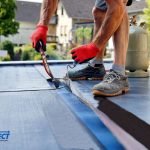EPDM Common Issues & Solutions
The synthetic rubber membrane, EPDM, boasts a long lifespan and great durability, often lasting up to 50 years with minimal maintenance and covered under a 25-year manufacturer’s warranty. A strong roofing material, the sheet is resistant to environmental factors like UV rays and weathering and has excellent waterproofing abilities. But like all roofing types, it’s not immune to faults or wear and tear, especially if improperly maintained or regularly inspected. Here are a few common problems you can expect with EPDM:
Ponding water
Ponding water on a flat rubber roof is often improper installation and structure, where the roof is not adequately sloped, which causes water to accumulate and “pool” in certain areas. Not being able to identify the signs of pooling early can be detrimental to the lifespan of your roof as it can accelerate the degradation of the membrane, causing leaks and structural problems. It’s recommended that you carry out regular inspections and maintenance of your flat roof to identify and rectify any of these problems early on to save time and money on bigger repairs later down the line.
Shrinkage
Shrinkage of the membrane typically occurs when, during installation, the membrane was not provided with enough time to “relax” or failed to fully adhere.
On top of this, EPDM rubber can also pull back over time due to ageing, UV exposure, poor maintenance and installation. In the case of the EPDM membrane bubbling, evidence points to improper bonding, where you’ll need to peel back the membrane and reapply it.
Roof leaks
Roof leaks are a problem for any roof and are often a cause for concern on rubber roofs, which haven’t been properly maintained, especially over periods of heavy rainfall.
While EPDM rubber is waterproof and designed to protect your home regardless of the weather conditions, it can be a problem if there’s been inadequate maintenance or installation.
Thankfully, EPDM is easily patched up. See: Flat Roof Extension, Repair and Replacement.
Damaged flashings
Flashing’s job is to keep water away from the parts that are more easily damaged by moisture, hence they act as a seal around vulnerable areas like vent pipes and chimneys. Over time, these flashings can become corroded, damaged or experience failure in their adhesion, which can cause leaks. A professional roofer, however, can easily inspect and replace the worn or damaged flashings.
Or, for example, roofers can use our flashing tape for repairs where extra waterproofing is essential, whether temporarily or permanently. See products.
Incorrect installation
The most common reason for EPDM roofing failures and issues is poor installation. When the membrane has not been properly applied and adhered to the roof substrate, or the seams have been inadequately sealed, then you’re opening your home up to leaks, moisture infiltration and premature roof failure. To avoid this problem completely, ensure you’ve hired an experienced and certified rubber roofing professional, who has a proven track record installing successful EPR membranes.
Please note that installation can fail due to improper sealing or poor seam quality, it’s essential you purchase high-quality EPDM adhesives and primers to successfully connect the individual membrane sheets together. By repairing and replacing faulty seams quickly, you can prevent bigger, more expensive problems. Buy EPDM adhesives.
Punctures and tears
Punctures and tears can happen on a flat roof for various reasons, including foot traffic, sharp objects being dropped on the roof and as simple as falling branches. Again, it’s important to inspect and maintain your roof regularly to remove the build-up of debris, which could cause a tear or puncture to the membrane.
If a puncture or tear exists, it provides an opening for water to penetrate the membrane, which can lead to leaks and possible damage to the underlying roof structure.











